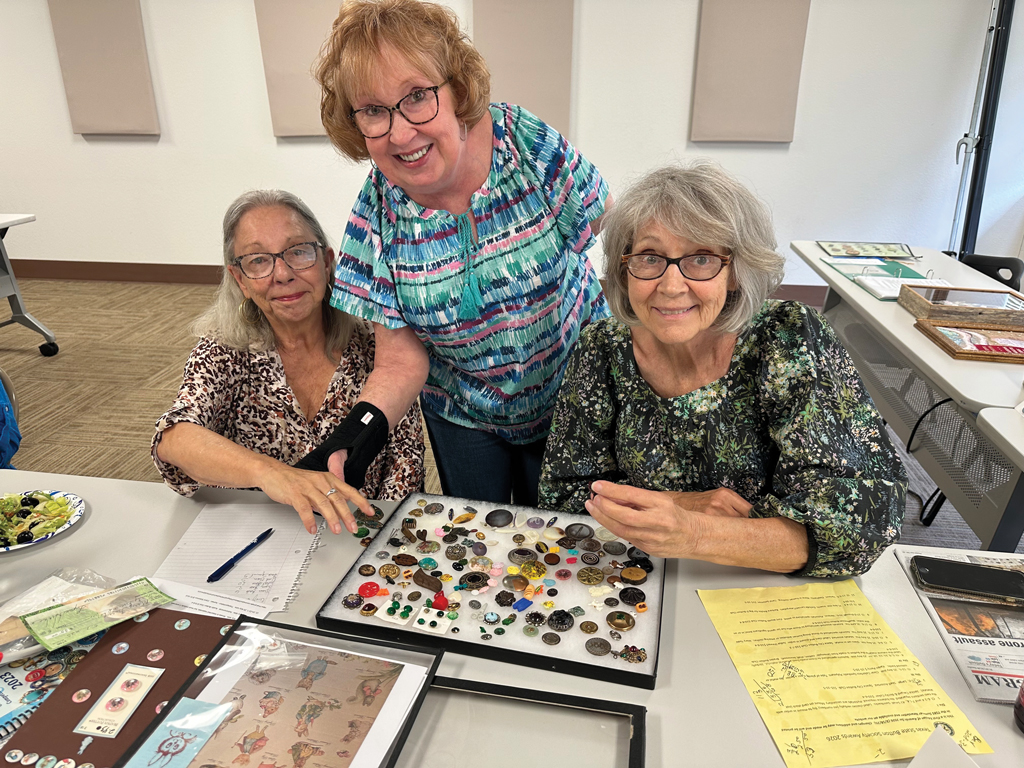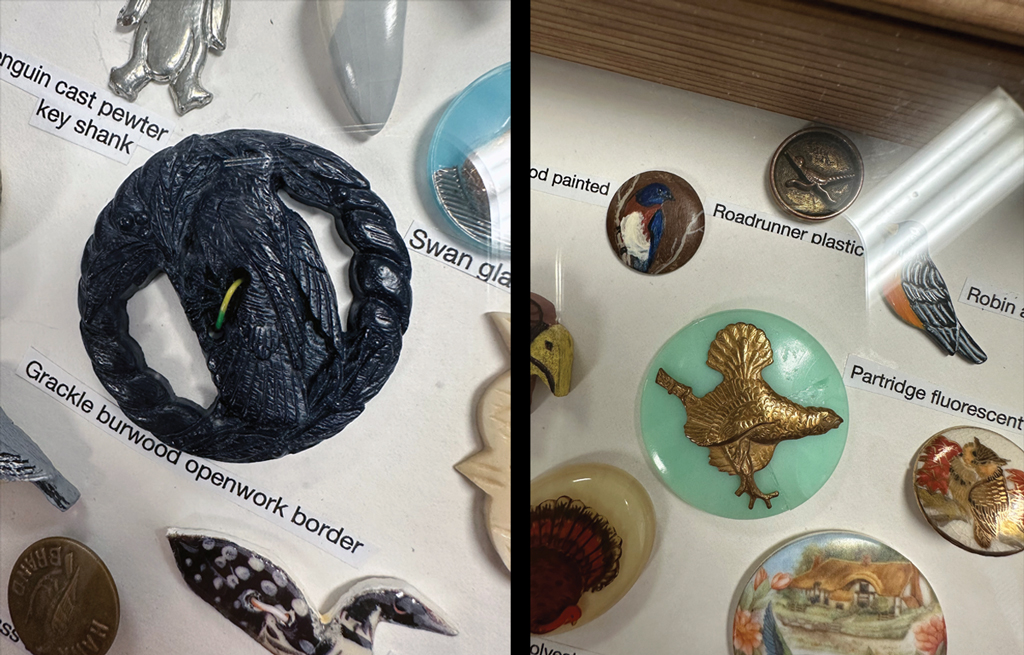Button culture, aesthetics and utility on display at Burnet County Area Fair

Jan Graves of Marble Falls at the May meeting of the Bluebonnet Button Club in Burnet. Graves is also superintendent of the Button Division for the Burnet County Area Fair, which is June 13-14. Staff photos by Suzanne Freeman
Roll call at a Bluebonnet Button Club meeting has nothing to do with attendance and everything to do with which buttons members bring to show, share, and study. For the May meeting, letters of the day were L and M, so the focus was on learning about leather, locket, Leo Popper, Luckyday, livery, mother of pearl, military, moonglow, and metal buttons, among others.
Buttons are brought to meetings in bags and cans, on cards, and in displays called trays. For state and national button society contests, fasteners are grouped and arrayed by theme, attached to colorful backgrounds by hidden wires, and framed.
During the 2025 Burnet County Area Fair, which is June 13-14, button art can be submitted in eight different categories, including jewelry, holiday craft, and stuffed animals.
Marble Falls club member Jan Graves will be on fair duty at a table of button entries wearing one (or more) of her many handcrafted button bracelets. As the superintendent in charge of the division, she can’t enter, but that doesn’t stop her from enjoying the art and camaraderie of button collecting, which has always been a part of her life.
“My mother took our old clothes and put them in a rag bag, but you don’t want to use a rag with buttons,” she said. “I was always in charge of removing the buttons. Over the years, I have filled a number of button boxes. Some are in cookie and candy tins and metal Quaker Oat(s) and Cracker Jack tins.”
She keeps a small collection of rhinestone buttons in a vintage glass Avon skin cream decanter.
Like most collectors, Graves sorts buttons by color and theme. The more unusual buttons are kept apart from the everyday buttons, and the glass and plastic are separated from the metal. When she was a Marble Falls ISD kindergarten teacher (yes, THAT Ms. Graves of yellow rug fame), she brought her buttons to class for crafts. She often used them in math exercises.
“Most of us don’t give much thought to buttons,” she said, “unless we lose one from our clothing.”
Bluebonnet Button Club members always have buttons on the brain.

Club President Barbara Hefner of Llano bangs meetings to order with a button-covered gavel. She also uses it quite often to quiet raucous discussions between excited button collectors.
“We’re like horse traders,” member Kathy Hurst said. “These little buttons are works of art, and we all have our favorites.”
Hurst travels from San Antonio to the meetings, which are held in the AgriLife building in Burnet beginning at 10:30 a.m. on the first Wednesday of the month from September to June. Her favorite buttons include anything from the Victorian era (1837-1901) to art deco (1919-39).
“Buttons reflect the Industrial Revolution,” Hurst said. “They follow politics and climate. Our goal is to find out why this button was made out of this material, at this time, and what it was made for.”
Lynn Huck of Liberty Hill loves buttons from World Wars I and II.
“I love mostly the history of where they came from and how the world wars had an impact on buttons,” she said.

She has a collection of black glass buttons used when King George VI died. A large grackle button made of burwood, ground-up wood, and glue injected into molds is another favorite, which she included in a tray of bird buttons she entered in a competition.
Going back to the horse trader metaphor, Mary Furey of Copperas Cove once bought her granddaughter a horse with the proceeds from button sales.
“I’ve been around buttons since I was a kid,” Furey said. “My husband asked me one day, ‘What are you going to do with all those buttons?’ so I became a seamstress.”
She’s now retired but still in the button business, along with daughter Colleen, who is a fellow button club member. When asked if Copperas Cove was too far to drive, Furey answered enthusiastically: “Not for buttons!”
Eileen Lyster of Waco drives even farther: 104 miles one way.
“Why do I do it?” she said. “I love the little things!”

She’s also a member of the Czech Heritage Society of Texas, which has a strong connection to button history. Thousands of families had been making glass buttons for centuries in the traditional Czech way until interrupted by World War II.
After the war, many of them migrated to southern Germany, taking their equipment with them. Around 100 of these families are still making glass buttons using the same techniques, and in some cases, the same machines that have been in their families for generations.
Hurst is another collector of Czech buttons. For the May roll call, she brought a tray of blue moonglow buttons from what is now the Czech Republic. She pulled out another tray of buttons, all from the 1800s, she said were worth around $25 each.
“My husband went with me to a state button show once and asked me to tell him what made a $250 button,” she said. “I said, ‘Someone who is willing to pay $250 for a button.”
Collectors also refer to the National Button Society Blue Book, which publishes a new edition of classifications and competition guidelines each year, for guidance on pricing.
Bluebonnet Button Club members are part of the Texas State Button Society, which also meets at the AgriLife building in Burnet. Several are state officers, including Hefner, who is president of both.
The Texas State Button Society’s fall 2025 workshop and sale, themed “Aloha Buttons,” is Oct. 14 in the AgriLife building.
Although the Bluebonnet Button Club has been around since 1999, buttons didn’t become a fair division until 2018. In 2017, the club held a road show in conjunction with the county fair. Members helped other button collectors determine the vintage and value of their buttons. The fair asked for a buttons division the next year.
Anyone with a button collection and a creative spirit can enter the fair. Guidelines are in the Burnet County Area Fair booklet or online at burnetcountyareafair.com.
Everyone is invited to stop by and admire the resulting artwork.
“If you stay around and visit with us, we will convince you of the joy of button collecting,” Graves said.
It certainly worked with this reporter!
Button basics
- The first buttons are believed to have been developed around 2000 BC in the Indus Valley, home to one of the world’s first large civilizations in what is now Pakistan and North India.
- These first buttons were ornamental, establishing a person’s status in society, and were made of shell.
- Buttonholes were invented in medieval Europe in the 13th century and revolutionized clothing.
- Mass production of buttons began during the Industrial Revolution (1760-1840).
- The word “button” comes from the French word “bouton” for bud or knob.

